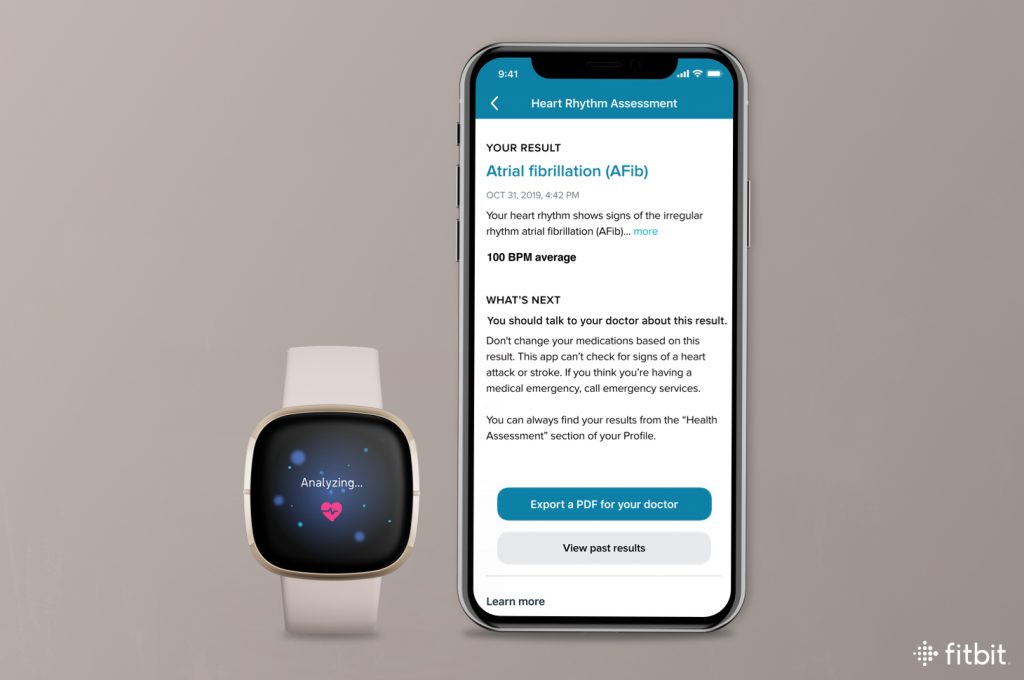
In the average lifetime our heart beats 2.5 billion times, working 24 hours a day, without a break—that’s a lot, and here at Fitbit, we appreciate just how important each heart beat is. We have been focused on helping users keep their hearts healthy from our earliest days with our PurePulse™ continuous heart rate technology, which is the foundation for so many of the features that we have today—like Daily Readiness, Cardio Fitness Level, Sleep Stages, Sleep Score, SpO2, High and Low Heart Rate Notifications, and Active Zone Minutes. These tools give our users deeper insights into their bodies and will continue to help people around the world.
Then in September 2020, we introduced our most advanced heart health technology yet that assesses your heart rhythm for atrial fibrillation (AFib), a heart rhythm irregularity, right from your wrist using the compatible ECG app on the Fitbit Sense.¹
Since then, we’re proud to report that our users have completed over 5 million heart rhythm assessments using Sense and now we’re bringing the same technology to a streamlined tracker design on the Fitbit Charge 5.
What is ECG?
An electrocardiogram, or ECG, is a test that measures and records the electrical activity of your heart. ECG tests help your doctor detect heart problems, such as AFib. AFib is an electrical problem in the heart where the upper chambers—called the atria—beat erratically, which causes the heart to beat in an irregular rhythm. However, it can be difficult to detect while you’re at the doctor’s as it’s inconsistent and can come and go at any point.
One way Fitbit helps identify AFib is with a spot check on your Fitbit Sense or Charge 5—using the compatible ECG app on your wrist, Sense or Charge 5 lets you check your heart rhythm for AFib on demand. Why is this important? The spot check can be taken by people at any time, including whenever they notice any unusual symptoms.
How does the ECG app work?
So, what’s the science behind it all? Well, your heart generates electrical activity that is responsible for the pumping action of the heart. Enter the two electrical sensors found on the corners of Sense and the left and right side of Charge 5. By making contact with one sensor on your wrist and the other with your opposite hand, you create a closed electrical circuit, which lets the ECG app record the electrical signals from your heart and analyze them for AFib.
How do I get started?
Simply open the ECG app on your Sense or Charge 5 and hold your fingers on the corners of the stainless steel ring for Sense or on the sides for Charge 5 while being still for 30 seconds. After assessing your heart rhythm, you’ll receive a reading from the ECG app showing you if your heart rhythm appears normal, shows signs of AFib, or if the assessment was inconclusive.
You can check your results both on-wrist and in the Fitbit mobile app (available in the Assessments & Report section of the Fitbit app). Your results can also be downloaded and exported into a PDF that you can share with your doctor.
Why is the ECG app with Sense and Charge 5 important?
At Fitbit, our ethos is driven by the desire to make the world a healthier place, which includes heart health. Normally, your heart beats in a regular rhythm like a metronome—when you have AFib, your heart beats in an irregular rhythm, which can lead to a stroke. AFib currently affects more than 33.5 million people globally. Fitbit’s compatible ECG app on Sense and Charge 5 can help users identify AFib and help get a better understanding of their heart.
This tool equips users with personalized information and knowledge of their heart rhythm, which gives the opportunity to have a more informed conversation with their doctor. This is important because with AFib, the heart may not always beat irregularly, making it hard to detect, and some studies suggest that as many as 25 percent of people who have an AFib-related stroke find out they have AFib only after a stroke has occurred.³ While the ECG app can’t diagnose AFib, the results can help individuals have a better conversation with their doctor.
¹ The Fitbit ECG app is only available in select countries; not intended for use by people under 22 years old. See fitbit.com/ecg for additional details.
³ Freedman B, Potpara TS, Lip GY. Stroke prevention in atrial fibrillation. Lancet. 2016;388:806–817
This information is for educational purposes only and is not intended as a substitute for medical diagnosis or treatment. You should not use this information to diagnose or treat a health problem or condition. Always check with your doctor before changing your diet, altering your sleep habits, taking supplements, or starting a new fitness routine.

If you have questions about a Fitbit tracker, product availability, or the status of your order, contact our Support Team or search the Fitbit Community for answers.
Please note: Comments are moderated and may not appear immediately after submission.